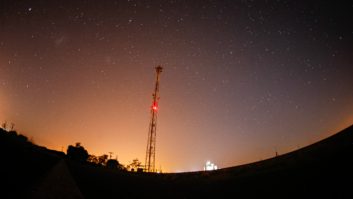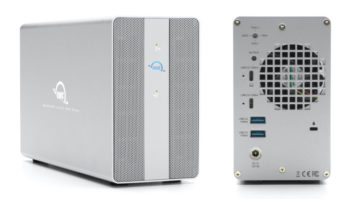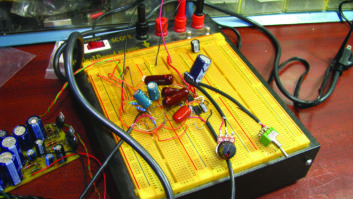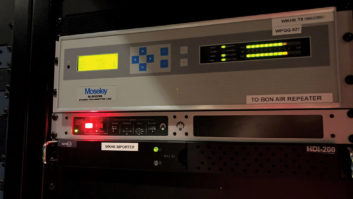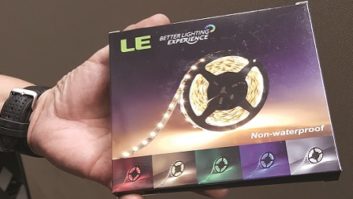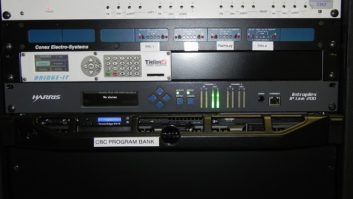LEDs Are Here to Stay
Sep 1, 2007 12:00 PM, By John Battison ,P.E., technical editor, RF
When building a new radio station or renovating an old one, it is normal to prepare a list of jobs to be done and items to be purchased. I’ve noticed it’s not unusual for someone preparing an equipment list to forget a comparatively small but important part of the complete installation.
Tower lighting requirements, which are specified in part 17 of the Commission’s rules, sometimes come as a financial shock. This is especially noticeable in the case of a multi-tower array. Radio station planners generally establish an operating budget with a conservative figure for primary electric power. Until recently, a large portion of the budgeted power had to be set aside for tower lighting and equipment. With the announcement of the LED-driven radio tower beacon, the experienced engineer found an economical, low-power consuming light source in place of incandescent lamps.

The beacon adapter (center) simplifies replacing incandescent lighting with LED lighting.
I discussed LED tower lighting in the January 2002 issue of Radio magazine when it was still an infant technology. That article aroused a great deal of interest in the area of antenna economies by virtue of the promised cost savings in tower lighting power. Since then, Dialight has expounded its development on the use of LEDs for tower lighting and published more information on this money-saving device. Probably the most important development is the retrofit adapter, which won a Radio magazine Pick Hit at NAB2007. This will probably help to weigh tower lighting decisions in future installations, because up until the development of this device it was rather difficult and time-consuming to convert to LED illumination. Previously, it was necessary to dismantle the old fixture and install a new base for the LED light fixture. This involves considerable time and expense in rewiring the base and performing uptower work.
An easy task
Replacing incandescent lamps with LED beacons is now a simple job using the Dialight D264 Series retrofit adapter. Made of cast aluminum with stainless steel fittings, the adapter interfaces with most existing tower lighting fixtures. The top of the existing incandescent light is removed and the retrofit adapter mounted on the existing hinge. A set of fixed positioning studs guides the new LED beacon into place and it is mounted on top. The new beacon is powered by a connection to the interface socket.
Development of the LED illuminated medium intensity red beacon has been followed by a dual-beacon that provides 20,000 cd white for daylight and 2,000 cd red light for night as a replacement for Xenon strobes. Final official ETL certification for the dual red/white beacon was received in May 2007.
The new beacon is microprocessor-controlled and goes to the flashing mode if equipment problems occur. However, the new retrofit adapter cannot be used with the new dual red/white medium intensity beacon and it is still necessary to replace the whole item.
Saving power
Most existing towers required to be lit day and night by the FCC already have adequate tower light wiring in place; but as time passes, wiring deteriorates and replacement becomes necessary. That is the perfect time to consider replacing incandescent lamps with LEDs. In many cases the use of LEDs results in considerable savings in wire gauge costs because of the much lower current requirements of LEDs.

LED lighting, such as this Farlight side marker, has established itself as a practical means of illuminating towers.
Copper prices seem to increase every week. At the present time, copper is high on the list of materials stolen from radio stations (ground systems especially). This saving is not confined to wiring alone. Austin tower lighting transformers are not exactly cheap, and the reduced power requirements of LEDs can often effect considerable savings in transformer costs. (Although it should be pointed out that in many cases it is possible to feed tower lighting power through the center of the copper tubing feed loop from the ATU to the tower.)
Dialight has provided some interesting figures in connection with lighting a 200-foot tower using LEDs compared with incandescent fixtures. These figures involve only the cost of the Austin transformer required to get ac power across the base. Nearly 200 pounds of dead weight (transformer) are taken off the tower loading and $1,700 in each tower cost. Long-term savings in power consumption and earning brownie points from the �green� groups are also additional benefits.
A typical medium-intensity red beacon will draw only 48W in normal operation and require fewer lamp replacement trips up the tower. Power savings are quite dramatic. A standard incandescent medium intensity-type L864 beacon uses only 48W compared to the 1200W required by incandescent lamps.
The load for the combination red and white medium intensity beacon has a nominal mode load of 60W when burning steady in the red, and only 260W nominal for white daytime flashing at the rate of 40 times a minute.
In connection with tower lighting, if you are using a folded unipole type of radiator it is extremely important to be sure the tower lighting wiring is mounted in a metal conduit properly grounded to the tower. If unshielded wiring is used with grounded towers, problems with antenna loading and matching are likely to occur because of variations in base operating impedance. The unshielded wiring can tend to work like an additional length of tower loading and thus affect impedance.
The versatile LED has come a long way from its humble beginning as a very useful, twinkling, panel indicator light with very low power consumption and minimum heat radiation. I wonder how many engineers gave any thought to the possibility of using large numbers of these highly efficient illuminators en masse as a source of bright beacon lighting hundreds of feet in the air in a hostile environment? Certainly the humble solid-state diode has come a long way from its roots as a simple half-wave rectifier.
E-mail Battison at[email protected].






